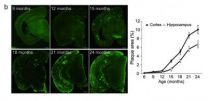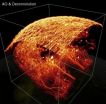(Press-News.org) Each year around 2,000-2,500 women are diagnosed with cervical cancer in England, the most common cancer in women under 35. Infection with high-risk human papillomavirus (HR HPV) types 16 and 18 is responsible for around 70-80% of cervical cancers. A study conducted by Public Health England and presented today at the Society for General Microbiology's Annual Conference shows a reduction in these two HR HPV types – which are included in the HPV vaccines used – in sexually active young women in England.
Between 2010 and 2012, over 4000 samples were collected from young women receiving a chlamydia screen as part of the National Chlamydia Screening Programme in England. Prior to the HPV immunisation programme introduction, a survey showed around 1 in 5 sexually active women aged 16 to 18 were infected with at least one of the two HPV types included in vaccines. A similar survey conducted following the introduction of the programme showed the prevalence had dropped to 1 in 15 young women.
Post-immunisation prevalence of HPV types 16 and 18 infection was lowest among women aged 16 to 18 year old, the age group with the highest vaccination coverage. Prior to the immunisation programme, this age group was shown to have the highest prevalence of infection.
David Mesher, Public Health England, presenting the work at the conference, said: "This study provides an early indication that the national HPV immunisation programme is successfully reducing vaccine-type HPV infections in sexually active young women in England, and also suggests herd-immunity may be benefiting non-vaccinated young women and men.
"The data provide reassurance that the high efficacy against HPV infection in women reported in clinical trials can be effectively realised in practice, and in a programme achieving high coverage amongst young females. These data adds to our confidence that the HPV immunisation programme will achieve its aim of reducing cervical cancer."
INFORMATION: END
Reduction in HPV in young women in England seen, following national immunization program
2014-04-14
ELSE PRESS RELEASES FROM THIS DATE:
Gene linked to pediatric kidney cancer suggests new strategies for kidney regeneration
2014-04-14
BOSTON (April 14, 2014)—Nearly one-third of cases of Wilms tumor, a pediatric cancer of the kidney, are linked to a gene called Lin28, according to research from Boston Children's Hospital. Mice engineered to express Lin28 in their kidneys developed Wilms tumor, which regressed when Lin28 was withdrawn, indicating that strategies aimed at blocking or deactivating the gene hold therapeutic promise for children with Wilms. Studies in the mouse model further suggest that controlled expression of Lin28 can promote kidney development and therefore may hold clues to regeneration ...
Mechanism, and possible treatment, for immune suppression in liver disease uncovered
2014-04-13
The mechanism which underlies the susceptibility of liver disease patients to life-threatening infection has been uncovered by Wellcome Trust-funded medical scientists, who have also suggested a possible treatment to reverse immune suppression in these patients.
Liver disease, or cirrhosis, is currently the fifth leading cause of death in the UK. Cirrhosis patients are more than five times more likely to pick up infections in hospital than patients with other chronic conditions, due to reduced immunity which is a well-recognised feature of the disease.
In a study published ...
How a Silly Putty ingredient could advance stem cell therapies
2014-04-13
ANN ARBOR—The sponginess of the environment where human embryonic stem cells are growing affects the type of specialized cells they eventually become, a University of Michigan study shows.
The researchers coaxed human embryonic stem cells to turn into working spinal cord cells more efficiently by growing the cells on a soft, utrafine carpet made of a key ingredient in Silly Putty. Their study is published online at Nature Materials on April 13.
This research is the first to directly link physical, as opposed to chemical, signals to human embryonic stem cell differentiation. ...
Fish from acidic ocean waters less able to smell predators
2014-04-13
VIDEO:
Scientists collected fish from the coral reefs shown here and found that fish from the more acidic waters of the bubble reefs were less likely to detect the odor of...
Click here for more information.
Fish living on coral reefs where carbon dioxide seeps from the ocean floor were less able to detect predator odor than fish from normal coral reefs, according to a new study.
The study confirms laboratory experiments showing that the behavior of reef fishes can be seriously ...
Hereditary trauma
2014-04-13
The phenomenon has long been known in psychology: traumatic experiences can induce behavioural disorders that are passed down from one generation to the next. It is only recently that scientists have begun to understand the physiological processes underlying hereditary trauma. "There are diseases such as bipolar disorder, that run in families but can't be traced back to a particular gene", explains Isabelle Mansuy, professor at ETH Zurich and the University of Zurich. With her research group at the Brain Research Institute of the University of Zurich, she has been studying ...
Glasses strong as steel: A fast way to find the best
2014-04-13
Scientists at Yale University have devised a dramatically faster way of identifying and characterizing complex alloys known as bulk metallic glasses (BMGs), a versatile type of pliable glass that's stronger than steel.
Using traditional methods, it usually takes a full day to identify a single metal alloy appropriate for making BMGs. The new method allows researchers to screen about 3,000 alloys per day and simultaneously ascertain certain properties, such as melting temperature and malleability.
"Instead of fishing with a single hook, we're throwing a big net," said ...
Virus-fighting genes linked to mutations in cancer
2014-04-13
Researchers have found a major piece of genetic evidence that confirms the role of a group of virus-fighting genes in cancer development.
Our understanding of the biological processes that cause cancer is limited. UV light and smoking are two well-understood cancer-causing processes. Exposure to either of these processes causes distinguishable patterns of genetic damage, or 'signatures', on the genome that can lead to cancer. All cancer-causing processes leave their own distinct imprint or signature, on the genomes of cancer cells.
The APOBEC family of genes control ...
Tiny particles could help verify goods
2014-04-13
CAMBRIDGE, MA -- Some 2 to 5 percent of all international trade involves counterfeit goods, according to a 2013 United Nations report. These illicit products — which include electronics, automotive and aircraft parts, pharmaceuticals, and food — can pose safety risks and cost governments and private companies hundreds of billions of dollars annually.
Many strategies have been developed to try to label legitimate products and prevent illegal trade — but these tags are often too easy to fake, are unreliable, or cost too much to implement, according to MIT researchers who ...
New mouse model could revolutionize research in Alzheimer's disease
2014-04-13
Alzheimer's disease, the primary cause of dementia in the elderly, imposes a tremendous social and economic burden on modern society. In Japan, the burden of the disease in 2050 is estimated to be a half a trillion US dollars, a figure equivalent to the government's annual revenues.
Unfortunately, it has proven very difficult to develop drugs capable of ameliorating the disease. After a tremendous burst of progress in the 1990s, the pace of discoveries has slowed. Dr. Saido believes that part of the difficulty is the inadequacy of current mouse models to replicate the ...
New technique takes cues from astronomy and ophthalmology to sharpen microscope images
2014-04-13
The complexity of biology can befuddle even the most sophisticated light microscopes. Biological samples bend light in unpredictable ways, returning difficult-to-interpret information to the microscope and distorting the resulting image. New imaging technology developed at the Howard Hughes Medical Institute's Janelia Farm Research Campus rapidly corrects for these distortions and sharpens high-resolution images over large volumes of tissue.
The approach, a form of adaptive optics, works in tissues that do not scatter light, making it well suited to imaging the transparent ...




